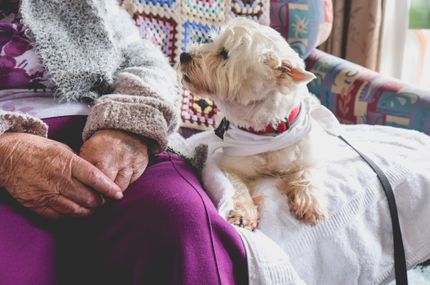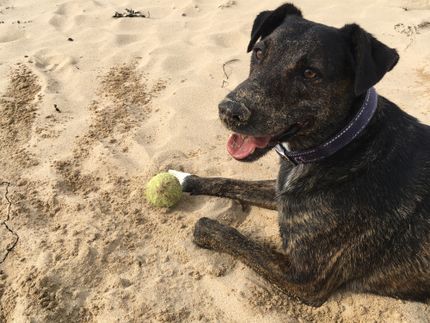Cav-A-Malt:Cavalier King Charles Spaniel and Maltese Mix
Facts & Origin
Cavalier King Charles Spaniel and Maltese mix - a hybrid breed.
Are you looking for a cute little dog that will love you unconditionally? Then meet the Cavalier King Charles Spaniel and Maltese mix! This unsuspecting mix is the best of both worlds: The Cavalier is a calm lap dog, and the Maltese is a play and fetch dog.
| Alternate Name | - |
| Origin | England - Malta |
| Life expectancy | 9 - 15 years |
| Care requirements | low-maintenance - high-maintenance |
| Activity level | low |
| FCI group | not recognised |
| AKC group | not recognised |
| KC group | not recognised |
More Cavalier King Charles Spaniel mixes
More Maltese mixes
Attitude, character and temperament of the breed
Possible character traits of Cavalier King Charles Spaniel and Maltese mix - Such is probably his nature.
The Cavalier King Charles Spaniel and Maltese mix are friendly, affectionate dogs that love to spend time with their family. This mix has inherited the best traits of both parent breeds and is known as an excellent companion dog. They are intelligent and eager to please, making them easy to train. Cavaliers are also very good with children and make excellent family dogs.
Cavalier King Charles Spaniels and Maltese mixes make great companions and relatively low-maintenance dogs, making them ideal first-time dog owners. They are good-natured and adaptable, so they can fit into most lifestyles and living situations. However, like all dogs, they need some exercise and daily walks. They are also quite active indoors and make excellent pets.
Overall, the Cavalier King Charles Spaniel and Maltese mix is a great choice for anyone looking for a loving, friendly, and low-maintenance companion dog.
Character
Usage


Health and breeding information
What diseases can occur in Cavalier King Charles Spaniel and Maltese mix.
There are a number of known health problems associated with the Cavalier King Charles Spaniel-Maltese mix breed. These include heart defects, eye problems, and joint disease.
Cavalier King Charles Spaniels are prone to a number of heart defects, the most common of which is mitral valve disease. This condition causes blood to leak from the left ventricle of the heart and can lead to congestive heart failure. Cavaliers are also prone to aortic stenosis, a narrowing of the aorta that can obstruct blood flow to the rest of the body.
Eye problems are also common in cavaliers and mix dogs. The most common of these conditions is syringomyelia, in which fluid-filled cavities form in the spinal cord. This can cause severe pain and neurological problems. Other eye diseases found in cavaliers include cataracts, glaucoma, and keratoconjunctivitis sicca (dry eye syndrome).
Joint disease is also relatively common in this mix. Hip dysplasia, a condition in which the acetabulum does not form properly, is particularly common. This can lead to pain, lameness and arthritis. Other joint diseases that have been reported in cavaliers include elbow dysplasia, patellar luxation (dislocation of the kneecap), and Legg-Calvé-Perthes disease (a condition that causes the head of the femur to die).
What does this mixed breed look like?
The Cavalier King Charles Spaniel Maltese mix has a short, silky coat that is white with tan markings. The coat is easy to maintain and does not require much grooming. This mix is also generally considered hypoallergenic, which makes them a good choice for those with allergies.
What are breed characteristics of this mix dog?
Cavalier King Charles Spaniel Maltese mixes are small dogs with a weight of 3-8 kg and a height of 20-30 cm. They have a silky, soft coat that is often white or cream in color. They have long ears and a long tail that is often curly. Their body is compact and they have short legs.
| Fur length | medium |
| Fur | flat coated - wavy |
| Ear shape | Floppy Ear - Triangle |
| Tail | fanned out |
| Anatomy | - |
| Size ♀ | 20 - 33 cm |
| Weight ♀ | 3 - 8 kg |
| Size ♂ | 21 - 33 cm |
| Weight ♂ | 3 - 8 kg |
| Suitable For | Beginner |
Known Diseases
valvular insufficiency
Heart valve diseases in dogs are among the most common heart diseases. Most often it is an acquired change in a heart valve.
Mitral Valve Diseas (MVD)
Mitral valve disease in animals and dogs, respectively
Curly Coat Dry Eye
Eye disease in dogs.
Kidney disease
Symptoms of kidney disease in dogs: increased urination (polyuria) increased water intake. Inflammation of the mucous membrane of the mouth. Loss of appetite
Eye diseases
Often occur with allergies and intolerances.
Skin inflammations
Can be hereditary in certain breeds.
Heart disease
Can occur frequently in dogs and can sometimes be treated with medication.
Patellar problems
Problems with the Patellar can be a displacement or weak kneecap, which is one of the most common causes of lameness in dogs, also because of overweight.
FAQ
-
The average life expectancy of a Cavalier-King Charles Spaniel-Maltese mix is 12 to 15 years.
-
No, Cavalier King Charles Spaniels and Maltese mixes do shed, but they are not considered to be very shedding, in fact they are considered to be hypoallergenic.
-
The average size of a Cavalier-King Charles-Spaniel-Maltese mix is 20-30 cm.
-
Common health problems in Cavalier King Charles Spaniels and Maltese mixes include patellar luxation, congenital heart abnormalities, and progressive retinal atrophy.
-
Yes, Cavalier King Charles Spaniels and Maltese mixes are usually good with children. They are known to be gentle, affectionate and patient.
Useful Articles
You can find articles that might interest you in the dogbible blog to match your favorite breed.
Visit our magazineto stay up to date on dog trends.
To find out more, view our Privacy Policy
Find here the breed that suits you and find out what character traits it has. Here you can also learn more about the origin, size and weight of your favorite breeds.
Matching your favorite breed, you'll find articles that might interest you on the dogbible dog blog.
What is a clicker and what does it do for dog training?
Cancer in dogs - cause, diagnosis, prevention of cancer in dogs
Lake Garda with dog - Dog runs, Bathing place for dogs, Dog beach on Lake Garda

















